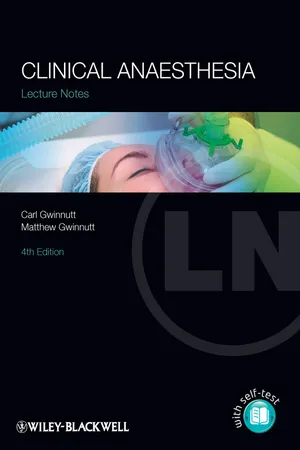
- English
- ePUB (mobile friendly)
- Available on iOS & Android
Clinical Anaesthesia
About this book
Perfect for medical students, junior doctors, anaesthetic nurses and allied health professionals, Lecture Notes Clinical Anaesthesia provides a thorough introduction to the modern principles and practices of clinical anaesthesia.
Full-colour diagrams, photographs and key fact boxes support easy understanding of the theory of anaesthetics allowing confident transfer of information into clinical practice.
This fourth edition has been fully revised and updated to reflect recent developments within the anaesthetics specialty and is fully supported by a wide-range of self-assessments for study and revision purposes together with a range of 'tips for anaesthesia attachments' that start each chapter.
Whether you need to develop your knowledge for clinical practice, or refresh that knowledge in the run-up to examinations, Lecture Notes Clinical Anaesthesia will help foster a systematic approach to the clinical situation for all medical students and hospital doctors.
Frequently asked questions
- Essential is ideal for learners and professionals who enjoy exploring a wide range of subjects. Access the Essential Library with 800,000+ trusted titles and best-sellers across business, personal growth, and the humanities. Includes unlimited reading time and Standard Read Aloud voice.
- Complete: Perfect for advanced learners and researchers needing full, unrestricted access. Unlock 1.4M+ books across hundreds of subjects, including academic and specialized titles. The Complete Plan also includes advanced features like Premium Read Aloud and Research Assistant.
Please note we cannot support devices running on iOS 13 and Android 7 or earlier. Learn more about using the app.
Information

- take a history and examine patients with particular attention to concurrent diseases that may impact on the conduct of anaesthesia;
- identify any risk factors for anaesthesia caused by any intercurrent disease processes;
- decide what further investigations are required;
- assess patients' airways and identify any potential difficulties with tracheal intubation;
- discuss an anaesthetic plan with an anaesthetist;
- witness consent being obtained for both general and regional anaesthesia;
- observe patients having echocardiography and cardiopulmonary exercise testing.
The Preoperative Assessment Clinic
Stage 1
- have no coexisting medical problems;
- have a coexisting medical problem that is well controlled and does not impair daily activities, such as hypertension;
- do not require any, or require only baseline investigations (Table 1.1);
- have no history of, or predicted, anaesthetic difficulties;
- require surgery for which complications are minimal.

- confirm the findings at the preoperative assessment;
- check the results of any baseline investigations;
- explain the options for anaesthesia appropriate for the procedure;
- obtain consent for anaesthesia;
- have the ultimate responsibility for deciding whether it is safe to proceed.
Stage 2
- coexisting medical problems that impair activities of daily living;
- the discovery of previously undiagnosed medical problems, such as diabetes or hypertension;
- medical conditions that are less than optimally managed, such as angina, chronic obstructive pulmonary disease (COPD);
- abnormal baseline investigations.
Stage 3
- have concurrent disease that impairs activities of daily living (ASA 3, see below);
- are known to have had previous anaesthetic difficulties, such as difficult intubation, allergies to drugs;
- are predicted to have the potential for difficulties, for example morbid obesity or a family history of prolonged apnoea after anaesthesia;
- are to undergo complex surgery with or without planned admission to the intensive care unit (ICU) postoperatively.
- make a full assessment of the patient's medical condition;
- evaluate the results of any investigations or advice from other specialists;
- request any additional investigations;
- review any previous anaesthetics given;
- decide on the most appropriate anaesthetic technique, for example general or regional anaesthesia;
- begin the consent process, explaining and documenting:


- discuss plans for postoperative care.
The Anaesthetic Assessment
Present and Past Medical History
Cardiovascular System
- ischaemic heart disease;
- heart failure;
- hypertension;
- valvular heart disease;
- conduction defects, arrhythmias;
- peripheral vascular disease, previous deep venous thrombosis (DVT) or pulmonary embolus (PE).
Table of contents
- Cover
- Title Page
- Copyright
- Dedication
- List of Contributors
- Preface
- Acknowledgments
- List of Abbreviations
- Chapter 1: Anaesthetic Assessment and Preparation for Surgery
- Chapter 2: Anaesthetic Equipment and Monitoring
- Chapter 3: Drugs and Fluids Used During Anaesthesia
- Chapter 4: The Practice of General Anaesthesia
- Chapter 5: Local and Regional Anaesthesia
- Chapter 6: Special Circumstances
- Chapter 7: Post-Anaesthesia Care
- Chapter 8: The Acutely Ill Adult Patient on the Ward
- Answers to Short-Answer Questions
- Answers to True/False Questions
- Index
- Advertisement